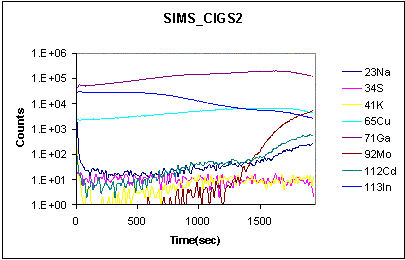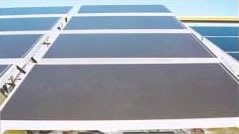
![]()
Thin film solar cells for terrestrial & space application
Development of CuIn1-xGaxSe2-ySy (CIGSS) thin film solar cells for terrestrial and space applications.
CuIn1-xGaxSe2-ySy (CIGSS) thin film solar cells are being developed at FSEC PV Mat Lab for terrestrial and space applications. Over last several years, excellent facilities have been developed for preparation and characterization of large 4”x 6” solar cells. These could serve as a nucleus of a pilot plant for fabrication of CIGSS thin film mini-modules.
Photoelectrochemical Water Splitting for Hydrogen Generation
Development of photoelectrochemical (PEC) cell for production of hydrogen and oxygen by water splitting.

Photoelectrochemical (PEC) cells are being developed by multiple bandgap combination of thin-film photovoltaic-cell and thinfilm-photocatalyst for production of hydrogen and oxygen by water splitting. Efficiency of PEC thin-film photovoltaic (PV) cell combined with catalyst will be increased by 1) an improved understanding of bandgap offset at the CIGS/CdS interface and 2) reducing the overvoltage required for water splitting by employing a photocatalyst that can be activated with infrared photons transmitted through the PV cell.
Module Long Term Exposure
 Side-by-side testing of PV modules in hot and humid conditions for comparison with tests in hot and dry conditions.
Side-by-side testing of PV modules in hot and humid conditions for comparison with tests in hot and dry conditions.
The goal of the module long-term exposure at FSEC is to carry out side-by-side testing of PV modules in hot and humid conditions and compare the results with those from hot and dry conditions. The following types of commercial modules from US PV module manufacturers are already being tested in the hot and humid climate in Florida: ribbon Si (ASE), amorphous hydrogenated Si (BP Solar SLX), monocrystalline-Si (Shell SSI), copper-indium-gallium selenide (Shell), and (a-Si:H) (USSC).
High Voltage Bias Testing of Thin Film PV Modules
Study of corrosion in amorphous hydrogenated silicon (a-Si: H) photovoltaic (PV) modules under high voltage bias in hot and humid conditions
 Over the last one year, PV Materials Laboratory of the Florida Solar Energy Center (FSEC) has being carrying out a detailed study of corrosion in amorphous hydrogenated silicon (a-Si: H) photovoltaic (PV) modules. Florida Solar Energy Center (FSEC) high voltage test bed consisting of eight a-Si:H modules were installed at following bias conditions: +600 V and –600 V, +300 V and –300 V, +150 V and –150 V , and two with no bias. The modules are monitored for leakage current through the electrically floating frames for each bias voltage, back of the module temperature at two locations, ambient temperature, solar irradiance and relative humidity. Readings are being taken at an interval of 15 seconds and average of all these readings for every 2 minutes are recorded. The data is procured after every eight hours. Any instances of excessive leakage current as well as parameters going out of expected ranges are flagged. Study of correlation of leakage currents against the relevant ambient meteorological elements such as module temperature and relative humidity with time is carried out on daily basis.
Over the last one year, PV Materials Laboratory of the Florida Solar Energy Center (FSEC) has being carrying out a detailed study of corrosion in amorphous hydrogenated silicon (a-Si: H) photovoltaic (PV) modules. Florida Solar Energy Center (FSEC) high voltage test bed consisting of eight a-Si:H modules were installed at following bias conditions: +600 V and –600 V, +300 V and –300 V, +150 V and –150 V , and two with no bias. The modules are monitored for leakage current through the electrically floating frames for each bias voltage, back of the module temperature at two locations, ambient temperature, solar irradiance and relative humidity. Readings are being taken at an interval of 15 seconds and average of all these readings for every 2 minutes are recorded. The data is procured after every eight hours. Any instances of excessive leakage current as well as parameters going out of expected ranges are flagged. Study of correlation of leakage currents against the relevant ambient meteorological elements such as module temperature and relative humidity with time is carried out on daily basis.
Tribological coatings
Development of tribological coatings having extremely high hardness, extremely low coefficient of friction, and high durability at temperatures lower than 60 K.
Tribological coatings having extremely high hardness, extremely low coefficient of friction, and high durability at temperatures lower than 60 K Tribological coatings are being developed to improve wear resistance and productivity, to reduce energy consumption, and to avoid lubrication or cooling stages. ion of coatings of Titanium nitride (TiN), molybdenum disulfide (MoS2), and their combination are being deposited by reactive magnetron sputtering and diamond like carbon (DLC) coatings are being developed by microwave assisted chemical vapor deposition.
